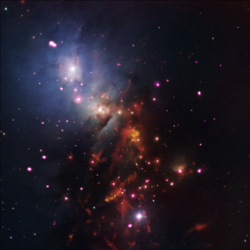 HEAPOW: Hot-Tempered Youth (2015 Sep 28)
HEAPOW: Hot-Tempered Youth (2015 Sep 28)
X-rays from stars like the Sun are produced by a complex interaction of the motion of the hot, ionized gas (or plasma) which makes up the star and the star's magnetic field, all driven by how fast the star spins. Young stars are thought to spin rapidly, and to possess strong magnetic fields and emit lots of high-energy X-rays. As stars age, they tend to rotate more slowly, and their X-ray emission drops. Understanding how this happens is an important piece to the puzzle of how life can arise and evolve, since intense X-ray emission can greatly effect planets in a star's habitable zone. Of course it's not possible to monitor a single star for billions of years, so to understand how a star's X-ray emission changes as the star gets older, astronomers study star clusters. Stars in clusters are all thought to have been formed at the same cosmic time, and the ages of star clusters can be determined fairly accurately. By comparing X-ray emission from stars in clusters of various ages, astronomers can determine on average how stellar X-ray emission varies with stellar age. The image above is a beautiful example of a multi-wavelength study of stars in the stellar cluster NGC 1333. This image is a composite X-ray image (in pink) obtained by the Chandra X-ray Observatory, along with an infrared image in red from the Spitzer Space Telescope, and an optical image (in red, green and blue) from the Digitized Sky Survey and the National Optical Astronomy Observatory Mayall 4-meter telescope on Kitt Peak. Many of the X-ray sources seen by Chandra are not detected in the infrared, indicating a population of X-ray bright young stars which have lost their surrounding cocoon of cooler accreting material.
CXC: NGC 1333: Stellar Sparklers That Last
Spitzer: Stellar Sparklers That Last
http://asterisk.apod.com/viewtopic.php?t=34938
| << Previous HEAPOW | High Energy Astrophysics Picture of the Week | Next HEAPOW >> |